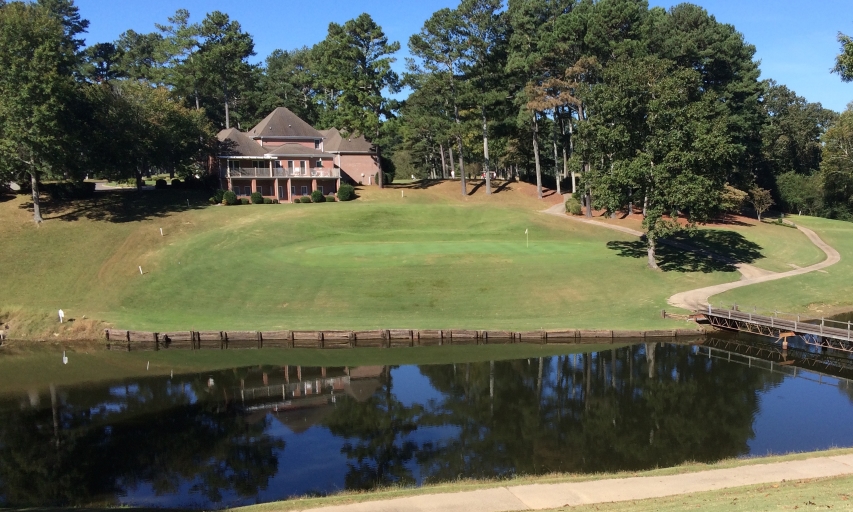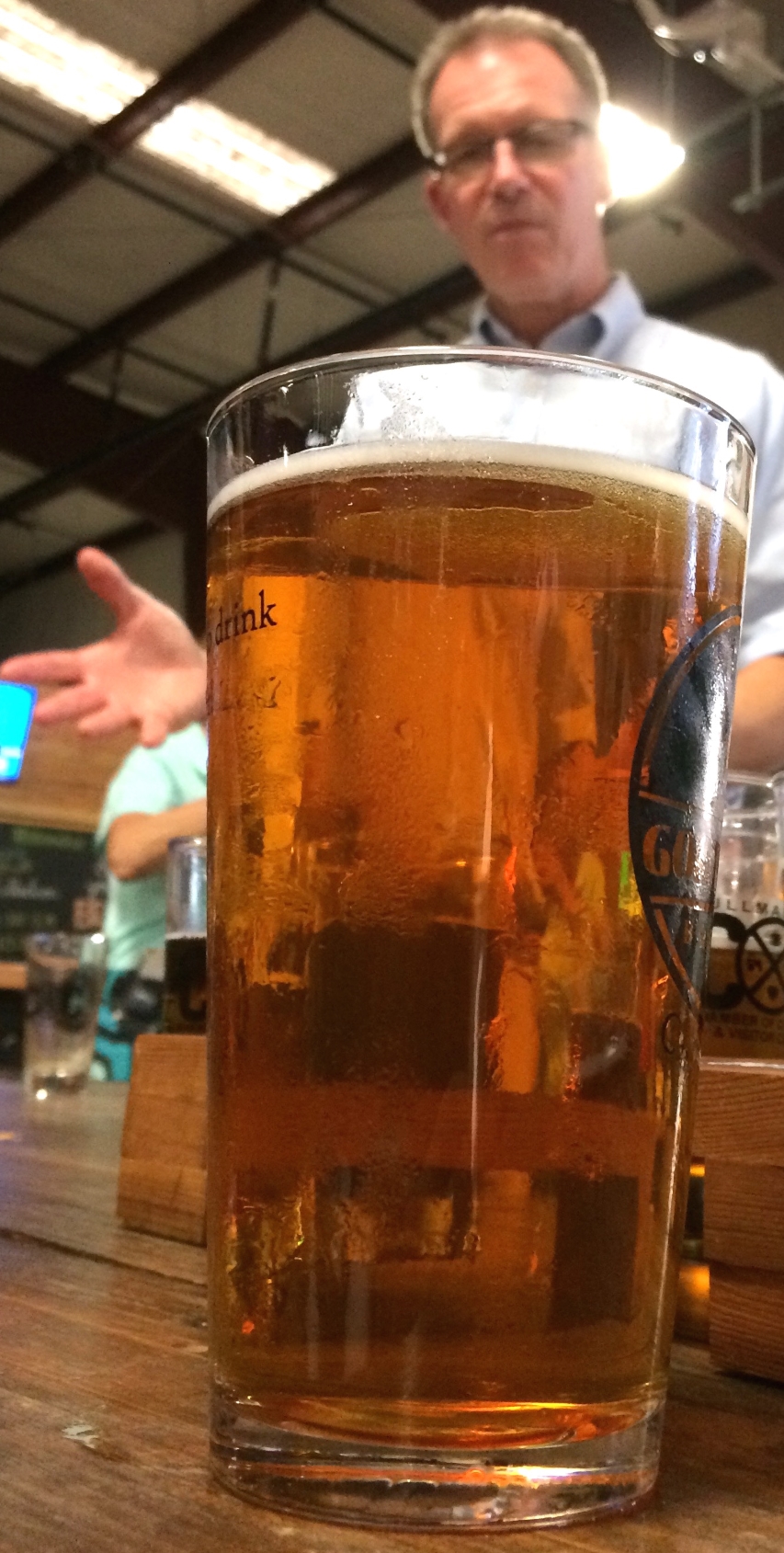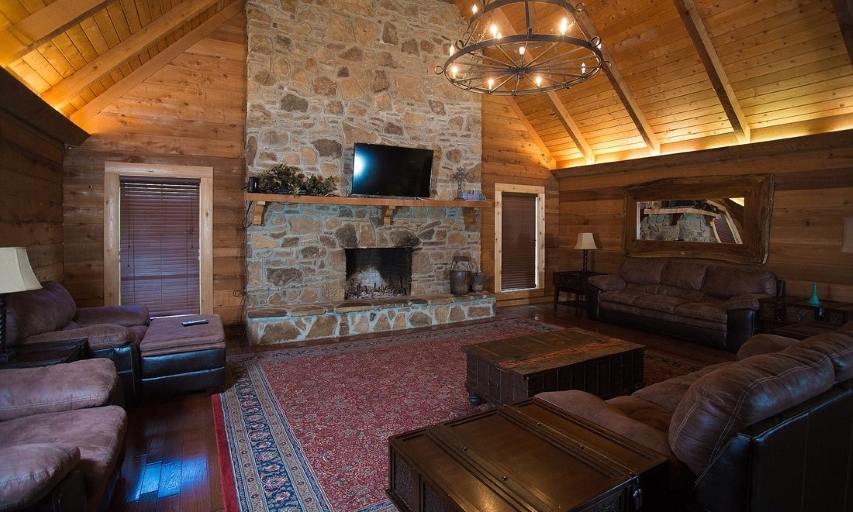Birdies, Bogeys, Beers, And Beds On The Robert Trent Jones Golf Trail
- Details
- Category: Inside Golf
- Published: 2017-11-03

(Photo by Gord Montgomery/Stone Bridge Farms)
By Gord Montgomery (iG)
HUNTSVILLE, ALABAMA — The best thing about the Robert Trent Jones Golf Trail is of course the golf. From the top to the bottom of Alabama, known by many as The Cotton State, you’re led on an ever-evolving run of courses that challenge your game, and your shot creativity. The thing is, while the golf is great here, as evidenced by the short course bios below, there is even more to this journey than simply swingin’ the sticks.
The Courses
It seems as though a week just isn’t enough time to inhale all the wonders of the Robert Trent Jones Golf Trail, and really, it’s not. My trip was staged on the northern end of the Trail and left one hungering for more of what this architectural genius had to offer. Here, in no particular order, are the four Jones Trail courses I visited along with two other tracks, that while not on this historical route, are a fun play nonetheless.
Hampton Cove — Highlands (rtjgolf.com/hamptoncove)
Changing subtly from a rolling course as it’s set in the foothills of the Appalachian Mountains to a parkland style, Hampton Cove Highlands is a test. While it’s not the longest track on the Trail (which is scary once you see the length from the back tees here), it does make you use every club in your bag.
Renovated in 2008, this 54-hole property changes its face drastically between the Highlands and the River Course, but the Highlands is likely the sternest of the two. Now resembling a true Scottish links layout, it opens with three dogleg holes where the greens are well protected by huge bunkers, a common Jones’ theme. While the fairways offer generous landing areas, if you wander a bit you’ll find the rough is deep and tangly, comprised of either fescue or Bermuda. The end result of ending up there means shots need to be played to simply get the ball out rather than advancing it any great distance.
The one noticeable thing about Highlands, and other Jones’ designs, is the size of the putting surfaces. One of the greens at Highlands is a full 62 feet long meaning the dreaded 3-putt is definitely in play here.
While Highlands may be one of the shorter courses on the Trail it is extremely playable, and enjoyable, from any of the numerous tee decks ranging up to 7,600 yards.

The 18th Hole At Fighting Joe Offers Players A Tough Par 3 But A Beautiful View Of The Waterway That Passes Close By. (Photo by Gord Montgomery/Stone Bridge Farms)
The Shoals — Fighting Joe; Schoolmaster (rtjgolf.com/theshoals)
Again, you run into two distinctly different tracks here, and likely two of the longest courses you’ll come across on the Trail.
Fighting Joe (named for famous Civil War general and statesman Wheeler) is located in Muscle Shoals and it can be a battle for short hitters, as this monster stretches out to over 8,000 yards off the back tees. So trust us here — if you’re going back there, make sure you’re a scratch golfer!
This links-style layout is quite straightforward — what you see is what you get. The sage advice from the starter was to play to the 150-yard markers because, he advised, that’s your best line of sight headed into the large greens.
“If you’re too far away, or too far past, that’s not a good thing,” we were advised about hitting to the suggested mark.
Curiously enough, this links layout doesn’t have any trees early on but you do run into those obstacles over the final three holes, including the monstrous 17th. As well, this track has an interesting end to both nines, where par 3’s come into play, something not seen on too many courses.
Needless to say, the two closing holes here are eye candy and a fine ending to what is a great track.
The SchoolMaster (named in honour of President Woodrow Wilson), stretches out to great lengths to challenge anyone’s game. From the tips you’re looking at 7,971 yards but as you move forward, this track which has most of the trees that Fighting Joe doesn’t, has fairways that can be hit more often than not and it offers up several good chances for great scores.
From the white boxes SchoolMaster plays to 6,160 yards, which is yardage enough given the rolling terrain, the lack of elevation and the tangly Bermuda rough surrounding the greens that’s pretty to look at but ugly to play out of.
The greens at SchoolMaster are a bit smaller than its brother’s but again, they do offer plenty of space in which to land your approach shots — not that it means you’ll end up close to he hole.
The most scenic hole here is likely the second, a par 3 with a waterfall to accent its beauty.
All in all, both of these courses make you use every club in your bag and make you think your way around. While you can pound out the big drives on both you do need to heed the hazards — but for the most part those are visible so they should be easy to avoid … right?

The Rolling Terrain Of The Backbreaker 9 At Silver Lakes Means That Many Fairway Shots Come From Uneven Lies, Making For A Very Challenging Test Of A Player's Abilities. (Photo by Gord Montgomery/Stone Bridge Farms)
Silver Lakes — Heartbreaker and Backbreaker (rtjgolf.com/silverlakes)
The names of the three different nine-hole layouts here say it all. These gorgeous tracks offer more challenges, both in fairway lies and putting green prowess, than imaginable.
There is a little bit of everything at Silver Lakes for everyone no matter which tee box you decide to play from. Broken into those three nines (Mindbreaker, Backbreaker, and Heartbreaker) these courses are what memorable golf trips are all about. Ranging from parkland to wetland, from the forests to heavily rolling terrain, Silver Lakes is one fun, and truly challenging, play.
Here again one finds the traditional huge greens that mark Jones’ layouts but these are different than others. The putting surfaces are Champion ultra dwarf grass and are as slick as anything you’ve ever encountered anywhere. Not only does the ball explode off your putter face, there is always at least one spine on each green to navigate, further testing your ability with the flat stick. The best advice here is to bump-and-run your approach shots toward the flag as often as possible since lofted shots don’t tend to bite very well.
Heartbreaker offers generous landing areas for tee shots but given the terrain, finding a flat lie is daunting. This nine plays long, especially if you back all the way up, at over 3,800 yards. The white boxes are more manageable for most players at a shade over 3,000 yards.
Once through with this nine it was off to Backbreaker where the cautionary words from the starter was, “Once you’re through with this nine you’ll see why they call it Backbreaker.”
With its elevation changes it’s often advisable to hit one, and sometimes two more clubs than you think necessary. A number of the greens on this routing are elevated, as are several tees, making for a fun nine holes of up-and-down, in more ways than one. Again, the greens are treacherous and it’s a necessity to look at your putt from more than one angle to have any hopes of walking away with no more than a 2-jack.
This part of Silver Lakes is also long from the back — over 3,800 yards but the white tees gives one somewhat of a break at just under 3,000 yards although the elevation changes make it seem a lot longer. This is a great play, if only for putting on the purest, fastest greens you may ever encounter on a public golf course.
Non-Trail Tracks
Goose Pond (goosepond.org)
Besides the wonderful gems one finds on the RTJ Trail, there are also delights to be had slightly off that beaten path. During our journey we had the chance to sample two fine courses, Goose Pond Lake Course in Scottsboro and TP Country Club in Cullman.
The Goose Pond Lake Course is an entertaining play located on Lake Guntersville. The beautiful lake (which is full of large mouth bass), isn’t a hazard on every hole but it is visible, or in play, on 15 of 18 holes. One of the biggest challenges here comes from the many subtle breaks on the greens.
Designed by George Cobb, the course is set in such a manner that it looks a lot harder than it is … as long as you keep your ball out of the water.

With The Clubhouse In The Background, This Pretty Little Par 4 At The TP Country Club Is A Fun Hole That Allows One A Good Chance At Birdie, As Long As You Keep Your Ball Out Of The Water And Hit Your Shot To The Right Tier On The Green. (Photo by Gord Montgomery/Stone Bridge Farms)
TP Country Club (tpcountryclub.com)
The TP Country Club (formerly Terri Pines) in Cullman, was a delight to both look at and play. This is a course with some dramatic elevation changes, and visuals. While only playing to 6,400 yards from the back tees, it is a true test for your short game.
The huge pine trees that are all around this course add a nice touch to you day, as they can provide some much needed shade when the sun beats down on you … but they can also make for some interesting shot shapes should your projectile end up behind one.
Designed by Tom Jackson, TP Country Club is one course that is worth jumping off the beaten path everyone follows in Alabama, and even though it is a private club, “Visitors are always welcome,” is their motto.

The Craft Brewery Industry Has Opened Up The Formerly Closed Liquor Laws In Alabama, With Plenty Of Great Tasting Refreshments Now On Tap. (Photo by Gord Montgomery/Stone Bridge Farms)
A Toast to the Trail
What’s a round of golf without a round, or two of beer? Well, in Alabama, that’s a question that is answered by the multitude of craft breweries that have sprung up around the state.
(Copy Supplied By Tom Bedell)
In terms of craft beer, the U.S. south was still so deep early in the 21st Century that it was submerged in a sea of Bud Light and other mass lagers. Remnants of Prohibition still clung to many southern states but the times are a-changing.
And nowhere is that more evident than in Alabama. From a few drops of craft beer in the barrel in 2011, Alabama became the fastest growing craft beer state in the nation over the next five years, surpassing 60,000 barrels, an astronomical growth rate of 6,380 per cent!
Northern Alabama has led the charge, particularly around Huntsville, to the extent that north Alabama’s tourist association (northalabama.org) has created an itinerary of 11 breweries that can be — for now — visited in a dedicated weekend’s time (bringing a designated driver recommended).
Stops along the Trail include, but aren’t limited to Straight to Ale and Yellowhammer in Huntsville, Singin’ River in Florence, Goat Island in Cullman and Back Forty in Gadsden.
The beers have great names such as Monkeynaut IPA, Frankenhammer, Pugilistic Zombie, IPAcalypse Now, Son of a Bridge Jumper and Naked Pig Pale Ale. All are varied in style and flavour and are uniformly good and the back story brewery yarns equally refreshing.
The very notion of a beer trail clearly borrows from the success of the state’s Robert Trent Jones Golf Trail. And so it only stood to reason that one of the breweries go in cahoots to produce some official swing oil for the RTJ Trail.
The Back Forty Beer Company of Gadsden, having first produced its Naked Pig Pale Ale in 2009, is the oldest of the northern Alabama craft breweries, and its Cart Barn Light, a 4.5% ABV [alcohol by volume] cream ale can be found at all RTJ Trail sites, in a can that resembles the Trail logo.
But the smart beer fan might opt to buy some offsite — there’s a discount coupon for Trail rounds to be found on the bottom of the six-pack.

The View In the Late Evening Of The Lake At The Goose Pond Colony Resort From One Of The Cabins Is Nothing Short of Spectacular. (Photo by Gord Montgomery/Stone Bridge Farms)
Where to Stay
On a road trip it can be a daunting choice when it comes to where to lay your head at night, but let us offer you a few suggestions of some out-of-this-world accommodation options.
Again, these are in no particular order but each and every one deserves an opportunity to lay out their hospitality for you.
The Goose Pond Colony Resort (goosepond.org/facilities/cottages) is home to, besides other sleeping options, 11 cottages that are in a word, outstanding. I camped out in a spacious 2-bedroom, 2-bathroom, 3-TV space that came complete with a small, but fully appointed kitchen. The common area was huge and the screened-in porch that overlooks the gorgeous lake added to both the size and the charm. As well, if you’re hauling a boat with you for some after-golf fishing for a shot at some large mouth bass, piers are provided.
If you’re more of a hotel type person, those are plentiful along the Trail and include ones that spoil you rotten, a space where both the Double Tree Suites by Hilton in Huntsville and the Marriot Shoals in Muscle Shoals fit in.
As to the former overnight hangout, what more can you say about putting your feet up for the night in a spacious well-appointed suite in a clean, modern hotel? Not much, but I’ll give it a try.
The Double Tree Suites by Hilton (doubletree3.hilton.com/en/hotels/alabama/doubletree-suites-by-hilton-hotel-huntsville-south) is a complex that features spacious two-room suites featuring private living rooms with sofa beds, LCD HDTVs, complimentary Wi-FI, spacious work areas, microwaves and refrigerators. If you’re looking to chow down after your round, simply stay on-site and enjoy American comfort cuisine in the hotel’s restaurant, Bistro 6K, a cozy and friendly venue that provides delicious food for the whole family.
As for The Marriott Shoals (marriott.com/hotels/travel/mslmc-marriott-shoals-hotel-and-spa), this stop is definitely one of the chain’s signature hotels. The resort boasts an unbeatable location in Muscle Shoals, an area of vibrant music history allowing you to explore where Aretha Franklin, Otis Redding and Bob Dylan recorded some of their hits.
Here, each room includes complimentary Wi-Fi, plush bedding and convenient room service. and you can dine at the 360 Grille, the revolving restaurant or enjoy a more casual meal at the Swampers Bar and Grille.
And, if you’ve found at the end of the day that your body is sore from hitting the golf ball so much, you can head to their beautiful spa, where you can indulge in a relaxing massage.

The Common Room In One Of The Massive Multi-Bedroom Places To Lay Your Head At Stone Bridge Farms Pretty Well Says It All About The Luxury Of This Stopover. (Photo by Gord Montgomery/Stone Bridge Farms)
Last, but certainly not least on this list is Stone Bridge Farms, and truth be told, while the other spots were great, this place is beyond belief.
Located in Cullman, the first word here is don’t let the web address (stonebridgewedding.com) scare you away. Stone Bridge Farms is an exceptional place to stay, especially when you’re part of a large group. While this spot caters to weddings, it is a great place for golfing buddies to relax around the pool or the fireplace, after a long day of birdies, bogeys, and craft beers.
I was fortunate enough to get the master suite in The Cottage, a huge 10,000 sq. ft., 5-bedroom complex with a fully equipped kitchen, a dining area, a spacious common room with a massive stone fireplace and a swimming pool out back.
Also available are three, 2-storey cabins that come with a fully equipped kitchen. If either of these don’t meet your needs, there are three other options: Villa Rica, The Lodge, and The Carriage Inn.
So while there is far too much to put into words about the wonderful experiences one can enjoy in Northern Alabama including the courses of the Robert Trent Jones Golf Trail, the craft beer industry and the accommodations offered, it’s advisable that you undertake this golfing journey of a lifetime and experience the great southern hospitality and the surprising beauty of The Cotton State.



